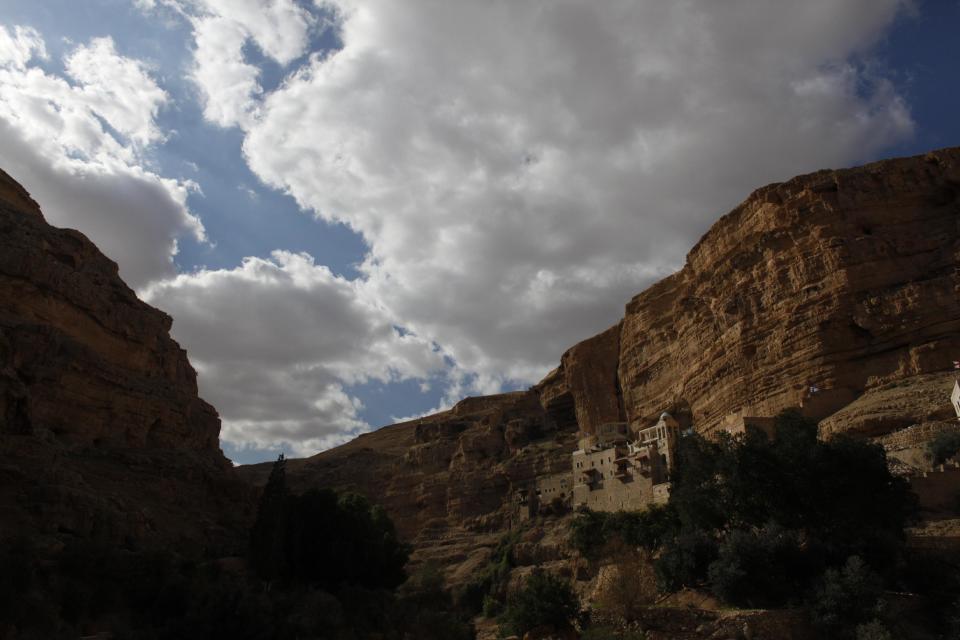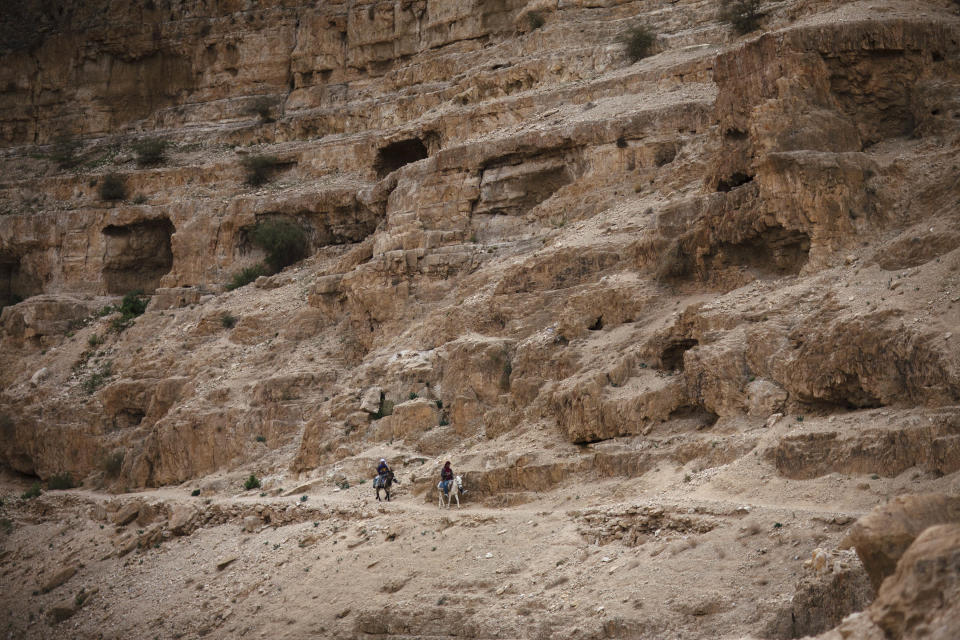Tourists find spiritual beauty in Judean Desert
JERICHO, West Bank (AP) — Located between Jerusalem and Jericho, the Judean Desert provided an inspiration to thousands of hermits who lived here in the early Middle Ages. With its breathtaking, rugged beauty, it was the perfect setting for those searching spiritual fullness in the emptiness of the desert.
Today only a handful of monks live here, but the desert and its stunning monasteries continue to attract thousands of visitors from all over the world.
With its majestic cliffs and arid rocks stretching to the sky, the Judean Desert is a spiritual place of eerie beauty.
During the fourth and fifth centuries A.D., it hosted a community of several thousand monks drawn by biblical stories and in search of a soulful experience. Away from earthly temptations, they lived a life of privation and isolation inside the dozens of caves scattered around this mountainous desert.
The desire to retrace the footsteps of early Christianity is still bringing pilgrims and tourists, said Elisa Moed, founder and chief executive of Travelujah.com, a faith-based website that provides resources for Christians traveling to the Holy Land.
"This is where John the Baptist resided. He was a hermit, and part of really experiencing the footsteps and really understanding the roots of Christianity is to come here and take a look at the wilderness and the landscape and try to understand the lifestyle of John the Baptist," she said.
The prophet Elijah "also spent his time in the Judean wilderness, Jesus spent time in the Judean wilderness. So, yes, it's a very important and very integral part of coming to the Holy Land and experiencing the Holy Land is to come into this wilderness," she said.
With its source of natural water, the gorge of Wadi Qelt in the West Bank, located a 20-minute drive from Jerusalem on the way to the Dead Sea, provides a green respite amid the arid landscape of the Judean Desert. This is where the Bible says the prophet Elijah lived, and it is the spot chosen by fifth-century hermits. In a reminder of the modern Middle East, vehicles must pass through Israeli and Palestinian checkpoints on the trip.
Visitors come here to visit the monastery of St. George built in the late 19th century on the site of an earlier monastery destroyed by the Persians in the year 614.
Today a small community of Greek Orthodox monks resides here, allowing visitors to view the monastery.
Two years ago, the road to the site was expanded, allowing a larger number of visitors, mainly from Greece and Romania.
Even with the improvements, Wadi Qelt continues to be off the beaten path. Buses can reach the entrance gate, but visitors have to walk down a winding path for about 15 minutes in order to reach the monastery, a potential hurdle for senior citizens or people with disabilities.
To those with walking difficulties, local Bedouin Arabs offer the option of covering the path on donkeys for about $20 to $30 (about 70 to 110 shekels).
A more common destination for pilgrim tours is the nearby Mount of Temptation, a 15-minute car ride from Wadi Qelt, near the Dead Sea.
Placed just above the West Bank town of Jericho, the monastery of the Mount of Temptation is on a cliff about 1,200 feet (360 meters) above sea level, surrounded by several natural caves.
Until the early 1990s, reaching the monastery required climbing up the hill and a great deal of determination. Today, a modern cable car today connects it to Jericho with a short and stunning five-minute ride above agricultural fields.
The monastery has just one permanent resident, Father Gerassimos, an 81-year-old Greek-Orthodox monk who's been living here for the past 30 years.
Throughout the year other monks reside with him for brief periods of time, said 34-year-old Father Galactio, who came from Greece to help Father Gerassimos for a few months.
The arrival of electricity and some modern comforts, like television and a kitchen, have changed the lifestyles of the Judean Desert monks; still, their main commitment is to praying and living a simple life.
Father Gerassimos' daily routine walks a fine balance between isolation and openness to the outside world: He wakes up at 6 a.m., attends mass in the monastery's church before hosting the many visitors who come every day.
The place closes at 5 p.m. Only then does Father Gerassimos resume his isolated life, just next to one of the caves inside the monastery once inhabited by Byzantine hermits.
Today that cell, with its religious icons, is part of the monastery's tour. In the fifth century, it was the place where monks led the hard battle of spirit against flesh.
Many of them chose the Mount of Temptation — where, according to the Gospel, Jesus was tempted by the devil — as the symbol of their resistance to worldly pleasures.
Other hermits, instead, moved to the dozens of natural caves of Wadi Qelt, said Benny Arubas, an archaeologist from Jerusalem's Hebrew University, who conducted a survey of the area in the 1980s.
"We documented here a series of hermit cells. This is what you see here, the remains of those caves and built cells. They are all along these cliffs," he said, pointing to the boundaries of a "laura," or local community of hermits who live alone during the week and get together on weekends.
In the fifth century, several thousand monks lived here in what they called "the desert of Jerusalem." Wadi Qelt provided them easy access to the Holy City and, at the same time, allowed them to live in seclusion.
This community of hermits diminished considerably after the Muslim conquest of the area in the mid-seventh century and the wars of the following centuries. Dozens of monasteries erected here were destroyed or abandoned and many of the hermits killed.
Still, the tradition lives on. One Romanian monk was so revered that a half-century after his death, his body remains on display inside a glass case at St. George.
"From time to time we hear or know about few monks — I mean, single ones — that practice a full ascetic life; they are being hermits, real hermits," said Yoram Tsafrir, a retired archaeologist from the Hebrew University who has studied the Judean Desert extensively. "For how long, I don't know, but I guess they try. This is the idea, this is the ideal, but it is very, very hard to reach that point of hermitage."
___
If You Go...
ST. GEORGE MONASTERY: The monastery is not included on standard Holy Land tours. Visitors may ask tour operators (or local priest for pilgrims) to include it on itineraries ahead of their trip. The site is a 15- to 20-minute drive from Jerusalem, followed by a 15-minute walk to the monastery's main gate. Tourists who are not part of an organized group can drive and park at the main gate, but rental cars must include West Bank insurance from one of the companies located in East Jerusalem; cars with Israel-only insurance won't be covered here.
St. George is located in an Israeli-controlled part of the West Bank. Vehicles returning to Jerusalem must pass through an Israeli-manned checkpoint; tourists usually pass through quickly.
MOUNT OF TEMPTATION: Organized tours of the Dead Sea may include a stop at the Mount of Temptation, located just above the town of Jericho. Visitors who are not part of an organized tour may reach Jericho by car (but rental cars must have West Bank insurance; see notes for visiting St. George above) or private taxi. Jericho is a 25-minute drive from Jerusalem on the way to the Dead Sea. A cable car connects Jericho to the Mount of Temptation and runs daily 8 a.m.-6 p.m. Tickets are about $14 (55 shekels).
The Mount of Temptation is located in a Palestinian-controlled area of the West Bank. At the entrance to Jericho, vehicles pass through a Palestinian-manned checkpoint. Vehicles returning to Jerusalem must pass through an Israeli-manned checkpoint at the entrance to the city; tourists usually pass through quickly.
TIP: An alternative for visiting both locations without an organized tour and without renting your own car is to hire a private tour guide with his or her own car. Cost ranges from $500-$600 for up to 125 miles (200 km) a day, up to nine hours a day.





